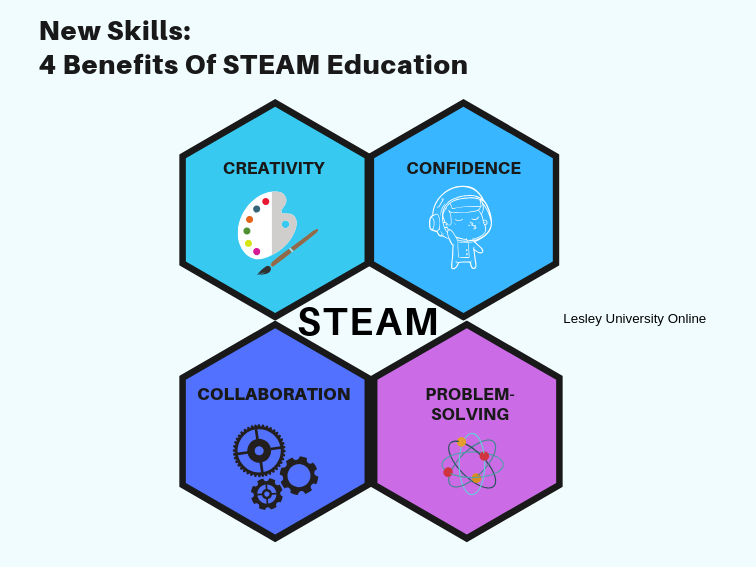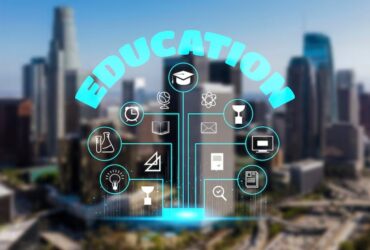Steam education is important because it integrates science, technology, engineering, arts, and mathematics. It fosters creativity and critical thinking skills.
It also prepares students for future careers in innovative fields. As technology continues to advance, a strong foundation in Steam education is crucial for students to thrive in a rapidly evolving job market. By engaging in hands-on, interdisciplinary learning experiences, students develop the skills necessary to solve complex problems and contribute to the advancement of society.
This holistic approach to education empowers students to become adaptable and resourceful individuals who can tackle real-world challenges with confidence. As a result, investing in Steam education is essential for cultivating a skilled workforce and driving future progress in various industries.
The Essence Of Steam Education
Steam education is vital for fostering innovation and critical thinking in students. By integrating science, technology, engineering, arts, and mathematics, students develop skills essential for future success in a rapidly evolving world. This interdisciplinary approach encourages creativity and problem-solving abilities, preparing students for diverse career opportunities.
Bridging The Gap Between Disciplines
One of the key aspects of STEAM education is its ability to bridge the gap between different disciplines. In traditional education systems, subjects like science, technology, engineering, arts, and mathematics are often taught in isolation, without much integration or connection between them. However, STEAM education recognizes the importance of interdisciplinary learning and encourages students to explore the interconnectedness of these subjects.
By combining science, technology, engineering, arts, and mathematics, STEAM education provides students with a holistic and comprehensive understanding of the world around them. It allows them to see how these disciplines relate to and complement each other, fostering a deeper appreciation for the interconnected nature of knowledge.
For example, through STEAM projects, students can see how concepts from mathematics can be applied to engineering, or how artistic creativity can enhance scientific problem-solving. This interdisciplinary approach not only helps students develop a more well-rounded and integrated understanding of the subjects but also prepares them for real-world challenges that often require a multidisciplinary approach.
Fostering Creativity And Innovation
STEAM education also plays a crucial role in fostering creativity and innovation among students. By incorporating arts and design into the traditional STEM subjects, it encourages students to think outside the box, explore new ideas, and approach problem-solving from multiple perspectives.
Through hands-on projects and experiential learning, students are given the opportunity to apply their knowledge and skills in creative ways. They are encouraged to brainstorm innovative solutions, experiment with different approaches, and learn from their failures. This not only cultivates their creativity but also instils in them a growth mindset, where they see challenges as opportunities for learning and improvement.
Moreover, the integration of arts and design in STEM education allows students to develop a sense of aesthetic appreciation and the ability to communicate their ideas visually. This combination of technical skills with artistic expression equips them with a unique set of tools to tackle complex problems and contribute to the ever-evolving fields of science, technology, engineering, and mathematics.
In conclusion, the essence of STEAM education lies in its ability to bridge the gap between disciplines, fostering creativity and innovation among students. By embracing an interdisciplinary approach and incorporating arts and design into traditional STEM subjects, STEAM education prepares students for the challenges of the future, where collaboration, critical thinking, and adaptability are essential skills. Through STEAM education, students are empowered to become well-rounded individuals who can tackle complex problems, think creatively, and contribute meaningfully to society.
Steam And The Future Workforce
STEAM education plays a crucial role in preparing the future workforce by fostering creativity and problem-solving skills. Integrating science, technology, engineering, arts, and math helps students develop a well-rounded skill set essential for the evolving job market.
As we look towards the future, it becomes increasingly clear that the job landscape is rapidly evolving. The skills that were once in high demand may no longer be relevant, and new skill sets are emerging as essential for success in the modern workplace. This is where STEAM education comes into play, ensuring that students are equipped with the necessary tools to thrive in the jobs of tomorrow.
With the integration of science, technology, engineering, arts, and mathematics, STEAM education goes beyond traditional learning methods. It encourages critical thinking, problem-solving, creativity, and collaboration – all skills that are highly valued in the ever-changing workforce.
By incorporating STEAM principles into education, students are prepared to adapt and excel in a variety of fields. They develop a solid foundation in science and technology, allowing them to navigate the digital landscape with ease. Additionally, the arts foster creativity and innovation, enabling individuals to think outside the box and approach challenges from different perspectives.
In the future workforce, adaptability is key. Industries are constantly evolving, and employees must be able to keep up with the latest advancements and trends. STEAM education cultivates adaptive thinkers who are capable of embracing change and finding innovative solutions.
Through hands-on activities and real-world applications, students are encouraged to think critically and analytically. They learn how to identify problems, design experiments, and develop hypotheses. This process of inquiry-based learning nurtures their ability to adapt to new situations and find creative solutions.
Moreover, STEAM education fosters collaboration and teamwork, which are essential skills in the workplace. Students work together on projects, sharing ideas and perspectives to achieve a common goal. This collaborative approach prepares them for the collaborative nature of many modern jobs, where teamwork and effective communication are vital.
In conclusion, STEAM education plays a crucial role in preparing students for the jobs of tomorrow. By integrating science, technology, engineering, arts, and mathematics, it equips learners with the skills they need to thrive in a rapidly changing workforce. From developing critical thinking and problem-solving abilities to fostering adaptability and collaboration, STEAM education lays the foundation for success in the future job market.
Beyond The Classroom: Real-world Applications
Steam education has become increasingly important in today’s world as it prepares students for the challenges they will face outside of the classroom. Beyond learning concepts and theories, steam education teaches students how to solve complex problems, encourages community and global engagement, and provides them with the skills they need to succeed in the real world.
Solving Complex Problems
Steam education teaches students how to think critically and solve complex problems. By using hands-on learning experiences, students learn how to analyze and interpret data, identify patterns, and make informed decisions. These skills are essential for success in today’s workforce, where employees are expected to be innovative and adaptable.
Encouraging Community And Global Engagement
Steam education also encourages community and global engagement. Through steam projects, students learn how to collaborate with others and work towards a common goal. This not only helps to build teamwork skills but also encourages students to think beyond themselves and make a positive impact on their community and the world.
Furthermore, steam education provides students with the skills they need to succeed in an increasingly globalized world. By teaching them about different cultures and customs, students learn how to communicate and work effectively with people from diverse backgrounds.
| Benefits of Steam Education: |
|---|
| Teaches critical thinking and problem-solving skills |
| Encourages community and global engagement |
| Prepares students for success in the real world |
Steam education is more than just learning about science, technology, engineering, art, and math. It’s about preparing students for success in the real world by teaching them how to think critically, solve complex problems, and work effectively with others. By embracing steam education, we are not only helping students succeed, but also building a brighter future for all.
The Role Of Technology In Steam
Integrating Cutting-edge Tools
Integrating cutting-edge tools into the STEAM education curriculum enables students to engage in hands-on learning experiences. By incorporating technologies such as 3D printers, robotics kits, and computer-aided design software, students can develop critical problem-solving skills and gain practical knowledge in science, technology, engineering, arts, and mathematics.
Promoting Digital Literacy
Promoting digital literacy is a crucial component of STEAM education. Through coding activities, digital simulations, and online research, students can enhance their understanding of technology and its applications across various disciplines. This fosters a deeper comprehension of digital tools and their role in shaping the modern world.
Steam For Inclusive Education
STEAM education plays a critical role in promoting inclusivity in the learning environment. By integrating science, technology, engineering, arts, and mathematics, STEAM education ensures that all learners have equal opportunities to excel and thrive. Let’s explore how STEAM contributes to inclusive education.
Breaking Down Gender And Ethnic Barriers
STEAM education fosters a learning environment where gender and ethnic barriers are dismantled. By emphasizing creativity and innovation, STEAM programs encourage girls to explore STEM fields and empower minority students to pursue careers in technology and engineering. This creates a more diverse and inclusive workforce in the future.
Creating Opportunities For All Learners
STEAM programs offer opportunities for all learners to engage in hands-on, experiential learning. By incorporating the arts and interdisciplinary approaches, students with diverse learning styles and abilities can thrive in a STEAM environment. This ensures that every learner has the chance to develop crucial critical thinking and problem-solving skills.

Credit: www.teachthought.com
Implementing Steam Education
Implementing STEAM (Science, Technology, Engineering, Arts, and Mathematics) education in schools is crucial for preparing students for the challenges and opportunities of the future. By integrating these disciplines, educators can foster critical thinking, problem-solving skills, creativity, and innovation in students. In this section, we will explore the strategies, challenges, and considerations involved in implementing STEAM education.
Strategies For Schools And Educators
Implementing STEAM education requires careful planning and effective strategies. Here are some approaches that schools and educators can adopt:
- Collaborative Projects: Encourage students to work in teams on real-world projects that integrate multiple disciplines. This fosters collaboration, communication, and the application of knowledge.
- Hands-on Learning: Provide students with hands-on experiences, experiments, and activities that engage their curiosity and allow them to explore concepts in a practical manner.
- Integration of Technology: Utilize technology tools and resources to enhance learning experiences and facilitate interdisciplinary connections. This can include using simulations, coding platforms, and online research.
- Cross-Curricular Connections: Identify opportunities to connect STEAM concepts with other subjects, such as integrating art and design principles into science experiments or using mathematical concepts in engineering projects.
- Professional Development: Offer training and professional development opportunities for teachers to enhance their understanding of STEAM education and develop effective instructional strategies.
Challenges And Considerations
While implementing STEAM education brings numerous benefits, educators may encounter certain challenges. It’s important to consider the following factors:
- Resource Allocation: Ensuring access to adequate resources, including materials, equipment, and technology, can be a challenge for schools with limited budgets. Finding creative solutions and seeking partnerships with local businesses or organizations can help overcome this hurdle.
- Curriculum Integration: Integrating STEAM concepts into the existing curriculum requires careful planning and coordination among teachers. Collaboration and interdisciplinary planning sessions can facilitate the seamless integration of subjects.
- Evaluation and Assessment: Developing appropriate evaluation methods to assess students’ understanding and skills in STEAM subjects is crucial. This may involve designing performance-based assessments and rubrics that capture the interdisciplinary nature of STEAM education.
- Teacher Support: Providing ongoing support and professional development opportunities for teachers is essential to ensure they feel confident and competent in delivering STEAM instruction. This can include mentoring programs, workshops, and access to resources and networks.
- Diverse Learners: Recognizing and addressing the diverse learning needs of students is essential in STEAM education. Differentiation strategies, such as providing alternative pathways or accommodations, can help ensure all students can engage and succeed in STEAM learning.
By implementing effective strategies and addressing the challenges, schools and educators can create a rich learning environment that prepares students for the increasingly complex and interconnected world they will navigate.
Frequently Asked Questions
What Are The Benefits Of Steam Education?
Steam Education benefits students by improving their problem-solving, critical thinking, and collaboration skills. It also promotes creativity and innovation.
How Can Steam Education Be Implemented?
Steam Education can be implemented by integrating STEAM subjects into the curriculum, providing hands-on learning opportunities, and using technology to enhance learning experiences.
What Careers Can Steam Education Lead To?
Steam Education can lead to careers in fields such as engineering, computer science, architecture, graphic design, and many more. It provides students with the skills necessary to succeed in a technology-driven world.
Does STEAM Education Help Younger Students?
Yes, STEAM Education supports younger students by building curiosity, early problem solving skills, and confidence through simple hands-on activities and age appropriate projects.
Is STEAM Education Expensive to Implement?
The cost varies based on resources and tools. Many schools start with low cost materials and basic projects, then expand as budgets and support grow.
Can STEAM Education Be Taught at Home?
Yes, parents can introduce STEAM concepts at home through simple experiments, creative projects, basic coding activities, and everyday problem solving tasks that build practical skills.
Conclusion
STEAM education plays a vital role in building strong creative and analytical skills. By bringing together science, technology, engineering, arts, and math, students gain a balanced foundation that supports problem solving, teamwork, and real world readiness. This approach helps learners adapt to new challenges and prepares them for careers shaped by modern technology and innovation. The value of this method becomes clear when asking Why Is Steam Education Important, as it encourages growth that goes far beyond textbooks. With STEAM, students build the confidence and abilities needed to become thoughtful, capable leaders in the future.












































Leave a Reply